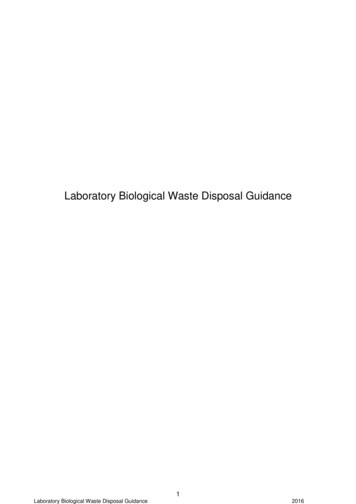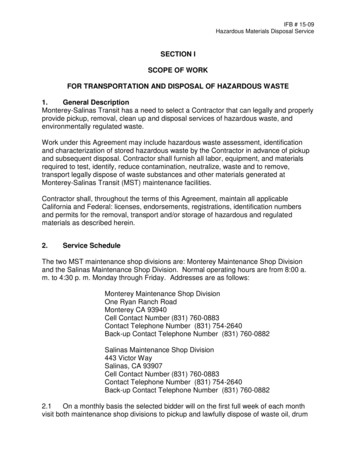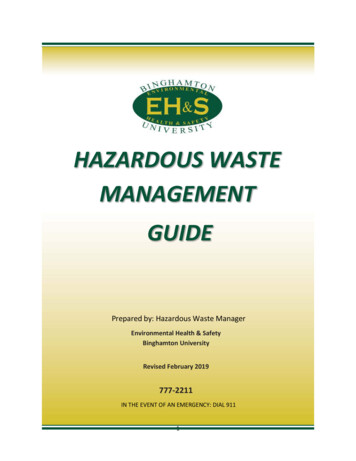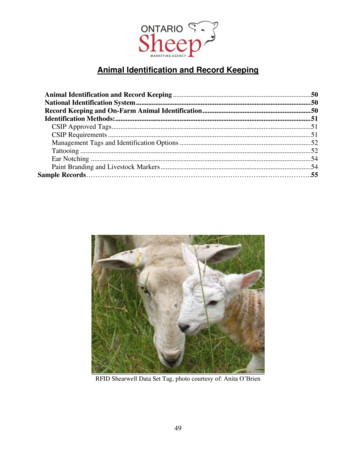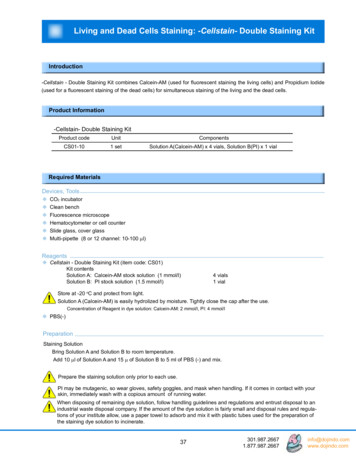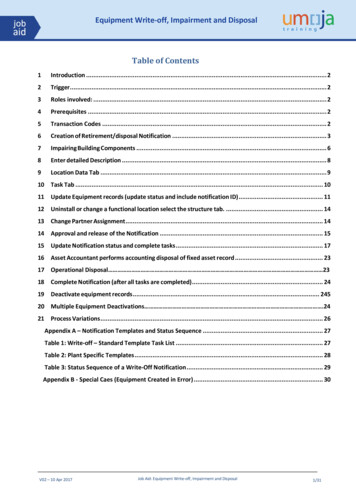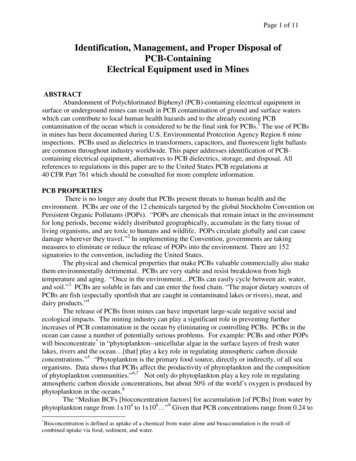
Transcription
Page 1 of 11Identification, Management, and Proper Disposal ofPCB-ContainingElectrical Equipment used in MinesABSTRACTAbandonment of Polychlorinated Biphenyl (PCB)-containing electrical equipment insurface or underground mines can result in PCB contamination of ground and surface waterswhich can contribute to local human health hazards and to the already existing PCBcontamination of the ocean which is considered to be the final sink for PCBs.1 The use of PCBsin mines has been documented during U.S. Environmental Protection Agency Region 8 mineinspections. PCBs used as dielectrics in transformers, capacitors, and fluorescent light ballastsare common throughout industry worldwide. This paper addresses identification of PCBcontaining electrical equipment, alternatives to PCB dielectrics, storage, and disposal. Allreferences to regulations in this paper are to the United States PCB regulations at40 CFR Part 761 which should be consulted for more complete information.PCB PROPERTIESThere is no longer any doubt that PCBs present threats to human health and theenvironment. PCBs are one of the 12 chemicals targeted by the global Stockholm Convention onPersistent Organic Pollutants (POPs). “POPs are chemicals that remain intact in the environmentfor long periods, become widely distributed geographically, accumulate in the fatty tissue ofliving organisms, and are toxic to humans and wildlife. POPs circulate globally and can causedamage wherever they travel.”2 In implementing the Convention, governments are takingmeasures to eliminate or reduce the release of POPs into the environment. There are 152signatories to the convention, including the United States.The physical and chemical properties that make PCBs valuable commercially also makethem environmentally detrimental. PCBs are very stable and resist breakdown from hightemperature and aging. “Once in the environment PCBs can easily cycle between air, water,and soil.”3 PCBs are soluble in fats and can enter the food chain. “The major dietary sources ofPCBs are fish (especially sportfish that are caught in contaminated lakes or rivers), meat, anddairy products.”4The release of PCBs from mines can have important large-scale negative social andecological impacts. The mining industry can play a significant role in preventing furtherincreases of PCB contamination in the ocean by eliminating or controlling PCBs. PCBs in theocean can cause a number of potentially serious problems. For example: PCBs and other POPswill bioconcentrate* in “phytoplankton--unicellular algae in the surface layers of fresh waterlakes, rivers and the ocean [that] play a key role in regulating atmospheric carbon dioxideconcentrations.”5 “Phytoplankton is the primary food source, directly or indirectly, of all seaorganisms. Data shows that PCBs affect the productivity of phytoplankton and the compositionof phytoplankton communities.”6,7 Not only do phytoplankton play a key role in regulatingatmospheric carbon dioxide concentrations, but about 50% of the world’s oxygen is produced byphytoplankton in the oceans.8The “Median BCFs [bioconcentration factors] for accumulation [of PCBs] from water byphytoplankton range from 1x104 to 1x106 ”9 Given that PCB concentrations range from 0.24 to*Bioconcentration is defined as uptake of a chemical from water alone and bioaccumulation is the result ofcombined uptake via food, sediment, and water.
Page 2 of 115.7x10-12 g/L in the North and South Atlantic oceans,10 PCBs can bioconcentrate inphytoplankton and then bioaccumulate in the food chain through phytoplankton being eaten byzooplankton which are in turn are eaten by small fish and then larger fish that enter the humanfood chain. The Federal Food and Drug Adminstration (FDA) has been compelled to issue thetemporary PCB tolerance of 2 ppm for human consumption of the edible portion of fish.11Polychlorinated Biphenyls were first commercially manufactured in the United States in1929 and rapidly found numerous industrial uses. PCBs have been used as dielectrics inelectrical equipment and as coolants in motors in continuous miners and loaders in the miningindustry. A common misperception is that because the regulations banned the manufacture ofPCBs in 1979, PCB-containing electrical equipment is no longer in use. The regulations,however, authorize the use of intact and non-leaking PCB-containing dielectrics in transformers,capacitors, and fluorescent light ballasts for the useful life of the equipment. Today, the miningindustry still uses PCB-containing electrical equipment, some of which continues to beabandoned underground. The abandonment of PCBs is not only a hazard to human health and theenvironment it also presents potential pollution-related liabilities to the mining industry.PCBs abandonment underground can cause long-term water pollution for which there may be nosolution.PCBs IN THE UNITED STATESPCBs were manufactured in the US under the trade name Aroclor before manufacturewas prohibited by the regulations in 1979. Aroclors, which are waxes or oils, were liquefiedusing technical grade tri and tetrachlorobenzenes, which give high-concentration PCB dielectricstheir characteristic odor. Aroclors are odorless; different aroclors have different percent chlorineweight fractions of PCBs that result in different properties. A typical aroclor is designated 1254.Twelve denotes the number of carbons in the PCB molecule and 54 denotes the percent chlorineweight fraction. Aroclor 1016, commonly used in capacitors, is an exception to thisnomenclature. Mixtures of PCBs and solvents were sold under the trade names that appear on themanufacturer nameplates of PCB electrical equipment and are referred to in this paper as PCBtrade name dielectrics. Some of the more common PCB dielectric trade names are Pyranol,Interteen, Elemex, and Chlorextol. There are many others. They contain, on average, about 60%PCBs. The generic name for these fluids is Askarel.PCBs are not the only chemicals used in mines. Underground repair facilities haveused chlorinated solvents such as trichloroethane, tetrachloroethene, and methylene chloride forcleaning and degreasing equipment. The release of these solvents, in addition to constitutingtheir own threats of ground water contamination, can mobilize PCBs, facilitating transport intoground and surface waters. Some mines maintain their own landfills which contain improperlydisposed PCBs and solvents.
Page 3 of 11Fig. 1This is a PCB Mark. Marks may also have a white background.IDENTIFYING PCB-CONTAINING ELECTRICAL EQUIPMENTThe regulations require transformers and capacitors containing three pounds or more ofdielectric be identified by PCB Marks (Fig.1), placed on the equipment by the owner or user ifthey contain 500 ppm (0.05%) PCBs. They are designated PCB transformers or PCBcapacitors. Mineral oil transformers containing 50 ppm (0.005%) PCBs are designated PCBcontaminated transformers. All of the above are regulated for use and disposal. This does notnecessarily mean that PCBs of lower concentrations or PCBs in small capacitors are nothazardous to human health and the environment. For purposes of this paper “PCB-containing”means dielectrics containing any detectable quantity of PCBs.
Page 4 of 11Fig. 276-gallon PCB (Pyranol) Transformers in the Eagle Mine at Gilman, Colorado, 1984PCB transformersPCB transformers (Fig. 2) may carry a PCB trade name on the manufacturer nameplate.The regulations require the assumption “ that a transformer manufactured prior to July 2, 1979,that contains .fluid other than mineral oil and whose concentration is not established, is a PCBTransformer ” and contains 500 ppm PCBs. If the date of manufacture or the type ofdielectric fluid is unknown, the transformer must be assumed to be a PCB transformer. PCBconcentrations must be established by chemical analysis or testing using SW 846-Method 8082and other methods12 (see ASTM D-4059) to document compliance with the regulations. Rebuilttransformers may carry replacement nameplates that do not correctly identify the dielectrics.Mineral oil transformers and voltage regulatorsTransformers with “oil” or “mineral oil”on the manufacturer nameplate originallycontained only mineral oil dielectrics but may have been contaminated with PCBs. Sometimesthere is no dielectric listed. This is common when a transformer has been rebuilt. Testing is theonly way to determine whether or not a mineral oil transformer has been contaminatedDielectrics of mineral oil transformers and PCB transformers were often mixed duringservicing resulting in transformers with mineral oil on the nameplates that may contain PCBs asa contaminant. In writing the regulations, EPA concluded the hazards of PCBs warrantedregulation in transformers at 50 and 500 ppm PCB. This is why mineral oil transformerscontaminated with 500 ppm PCBs are regulated as if they are trade name PCB transformers thattypically contain about 600,000 ppm (60%) PCBs. Voltage regulators and substationtransformers can become regulated PCB articles if internal small PCB starting capacitors leak(see PCB MANAGEMENT AND DISPOSAL).
Page 5 of 11Fig. 3PCB Marked Capacitor on the leftCapacitorsBy 1976, 95 % of the capacitors produced in the United States were filled with PCBs13(Fig.3). PCB capacitors contain the pure aroclors, 1242 or 1016. Manufacture before July 2,1979, or a PCB trade name on the nameplate is a good indicator of high concentration PCBs.The regulations require the assumption “that a capacitor manufactured prior to July 2, 1979, andwhose PCB concentration is not established, contains 500 ppm PCBs” and is a PCB capacitor.If the date of manufacture is unknown the capacitor must be assumed to be a PCB capacitor andassumed to contain 500 ppm PCBs. Because most capacitors are sealed units, that testing willrequire penetration of the casing that may destroy their usefulness and result in leaks which mustbe eliminated or contained. A helpful aid in identifying capacitors that do not contain PCBs isthat the regulations require capacitors manufactured between1978 and 1998 be marked “NoPCBs” by the manufacturer.
Page 6 of 11Fig. 4Fluorescent Light BallastFluorescent light ballastsTypical fluorescent light ballasts (Fig. 4) manufactured before May 31, 1979, contain asmall capacitor buried in the tar or asphalt potting material filling the ballast that functions as aninsulator. These capacitors hold about an ounce of aroclor. Asphalt material in fluorescent lightballasts manufactured before 1978 has been found to have a better than 50% chance ofcontaining regulated levels of PCBs.14 A helpful aid in identifying light ballasts is that theregulations require that ballasts manufactured between July 1978 and July1998 be marked "NoPCBs” by the manufacturer.
Page 7 of 11Fig. 5Lead Jacket Electrical CableElectrical cableElectrical cable (Fig. 5) can contain PCBs. In some cases, the cable is enclosed in a leadjacket which makes it difficult to handle. If electrical cable contains liquids or damp insulation,PCBs should be suspected.PCB REPLACEMENTReplacement of PCB dielectrics can be a good investment considering the potential costsof cleanup from PCB spills or fires. In the United States, PCB contamination can result inliabilities under the Comprehensive Environmental Response Compensation and Liability Act(CERCLA) at any concentration. Fires and explosions involving PCB-containing capacitors,transformers or any other PCB-containing electrical equipment, including transformers withcontaminated mineral oil dielectrics, can create polychlorinated dibenzo-p-dioxins andpolychlorinated dibenzofurans some of which may be more toxic than PCBs and not be easilycleaned up and can permanently shut down facilities.Mines and related facilities need not face these risks today because there are goodalternatives to PCBs on the market. Transformers, capacitors, fluorescent light ballasts, and cablemanufactured in the United States after July 2, 1979 should not contain PCBs. Mineral oildielectric fluids in transformers are common but can present fire and explosion hazards as canvegetable oil dielectrics when subject to high temperature faults within the transformer. Anumber of major United States power distribution companies have programs to eliminate PCBsand are adopting biodegradable vegetable oil dielectrics. Company representatives reportbiodegradability is an important consideration. Many coal and hardrock mining companies haveadopted dry-type transformers for underground use. Dry-type transformers are transformers inwhich the core and coils are in gaseous (usually air) or dry compound insulating mediums. Inexplosive atmospheres dry-type transformers must be in properly ventilated non-combustiblecontainers. Associated switch gear, or spark producing items, such as fuses, circuit breakers, andrelays must be in explosion proof enclosures.15
Page 8 of 11There are a number of PCB-free capacitor dielectrics on the market. Some of thesedielectrics can present their own hazards to human health and the environment and constitutefinancial risks if released into the environment.MINES AND PCBsUnderground and surface mines and the attendant crushing, milling, and smeltingfacilities may use PCB-containing electrical equipment. PCBs are most likely to be intransformers, capacitors, fluorescent light ballasts, cable, and drums of unidentified oils.Underground inspections have revealed transformers grouped in permanent substations, locatedsingly, or mounted on mine cars that can be transported throughout the mine. Capacitors arefound in locations similar to those of transformers. PCB capacitors have been found in electriclocomotives. In coal mines, PCB capacitors have been found in wheel or skid-mounted powercenters (Fig. 6).Fig. 6Coal Mine Power Center containing PCB CapacitorsInspections have revealed PCB electrical equipment in just about every major electricallypowered activity: in draglines in open-pit coal mines, power shovels in open-pit metal mines, andin discarded equipment. PCBs have been found in underground substations, pump stations, minepower centers, and electric locomotives. PCBs have also been found in surface facilitiesincluding hoist facilities, mills, smelters, metal refineries, breaker houses, and transfer facilities.Experts in the mining industry believe that substantial quantities of electrical equipment withPCB-containing dielectrics had been abandoned underground before the advent of the PCBregulations.16 Even after promulgation of the PCB regulations, PCBs have been abandonedunderground, especially in situations where it was not cost effective to remove them.
Page 9 of 11PCB MANAGEMENT AND DISPOSALThe following is a summary of ways to manage PCBs. This information should besupplemented by consulting the PCB regulations.Identify and inventory PCB-containing electrical equipment. Equipment should bemarked so it is easily recognizable and not disposed inadvertently. Written records identifyingPCB equipment and their locations are essential. Records should include a serial number fromthe manufacturer nameplate or a company assigned number that has been placed on theequipment, dielectric identification from the nameplate, dielectric quantity, and PCBconcentrations from lab analyses.Examine the equipment for leaks and clean up any leaks or spills potentially containingPCBs. A common concept of a leak is a drip, sometimes referred to as a weep or seep. However,a leak is defined in the regulations as any instance in which a PCB article (including atransformer, voltage regulator, capacitor, lead cable, or fluorescent light ballast) or container“ has any PCBs on any portion of its external surface.” This means a leak can be an oily film oroily dirt near any port or opening in the equipment. Leaks should be cleaned up and theequipment repaired or the leaking equipment containerized, moved to safe storage, and replaced.PCBs that have run off the equipment onto the concrete or soil below should be cleaned up andstored pending disposal. Personal protective equipment and cleanup materials may becontaminated with PCBs and require proper disposal.It is a good idea to replace and properly dispose of PCB-containing equipment that is nolonger needed, keeping in mind this can be a good long-term investment to avoid liability.Storage should be in a building with an adequate roof and walls that is in a locationselected to protect the PCBs from the possibility of release. Storage facilities should not be in aflood plain. Leaking equipment should be stored in metal drums with lids. Containment shouldprevent escape of PCBs into the environment through volatilization and containers should carryPCB marks. PCBs will penetrate most plastics.Be aware of hidden sources of PCBs. The largest single hidden PCB source resulting inimproper disposal is transformer bushings. The dielectrics in bushings have no fluid connectionswith the dielectrics in the transformers to which they are attached so analysis of the transformerdielectric will not reveal anything about PCBs in the bushing. Bushings can contain anythingfrom mineral oil to pure aroclor to tar-like compounds containing very high concentrations ofPCBs. “Pot heads,”cable termination apparatus that connect transformers to incoming powersources, can be filled with a tar-like material that can contain very high concentration PCBs.Any tar-like or asphalt-like material used as an insulator or dielectric should be suspected ofcontaining PCBs. Small motors often require starting capacitors that can contain PCBs. Voltageregulators and substation transformers can contain load tap changers operated by small motorsthat contain PCB starting capacitors. Small motor capacitors can leak contaminating thedielectric fluid. Asphalt material in fluorescent light ballasts along with lubricants and caulks areother potential sources. Air compressors have been serviced with PCB containing lubricants. Oilfilled switches, circuit breakers, and enclosures should also be suspect.It is of utmost importance to keep in mind the dangers and persistence of PCBs in theenvironment when deciding on storage locations and disposal. PCB-containing dielectricsrequire specialized disposal techniques that destroy the PCB molecule. Incineration of PCBcontaining dielectrics is the preferred destruction method. However, the PCB regulations require99.9999% destruction of the PCBs17 and incinerators can burn PCBs only if they obtain an EPAPCB disposal approval which includes successful completion of a trial burn to demonstrate thislevel of destruction. Inefficient incinerators or open burning can vaporize and disperse PCBsand convert them to even more hazardous dioxins. Disposal of PCB-containing dielectrics in
Page 10 of 11landfills is not permitted because of the potential for ground water contamination. If there are noadequate disposal facilities long-term storage will be your only option.The extent and complexity of underground mines present opportunities for abandonmentor illegal disposal of hazardous wastes. The presence of hazardous wastes may not be evidentuntil they are found in the local ground water. PCBs released underground from abandonedelectrical equipment can cause water pollution in mining districts which will eventuallyintroduce PCBs into the environment leading to contamination of the ocean and the human foodchain regardless of the location of their release.SUMMARYPCBs are hazardous not only to human health and the environment but also to the miningindustry because of potential worker exposure and improper disposal liabilities. Riskmanagement should be an important part of PCB management planning. PCB managers shouldtake into account not only the regulatory requirements for use and disposal, but also financialrisks that can result if PCBs are inadvertently released into the environment. Compliance withthe regulations will not protect against liabilities under other federal laws while minimalcompliance can result in unanticipated risks. For example, the regulations permit the disposal offluorescent light ballasts containing small capacitors with about an ounce of pure aroclor asmunicipal solid waste. Nevertheless, the preamble to the regulations states: “However, disposersof fluorescent light ballasts that contain a small PCB capacitor should be aware that they couldbe subject to CERCLA liability if the municipal solid waste landfill becomes a Superfund site.”18This small thimble sized capacitor contains enough aroclor to contaminate 166 gallons ofmineral oil at 50 ppm. Liability under CERCLA can be nearly unlimited for PCBs at anyconcentration if they get off site and present what may be considered an “imminent andsubstantial” endangerment to public health or the environmentReplacement and proper disposal of PCB-containing dielectrics can protect you fromfuture liabilities.Dan Bench, A mining engineer is the U.S. Environmental Protection Agency Region 8 PCBCoordinator (E-mail: bench.dan@epa.gov or 303-312-7090, the Mining Hotline). For theregulations and more information on PCBs check www.epa.gov/pcb.The views in this article express the opinions of the author and do not necessarily reflect EPApoliciesREFERENCES1. Celine Goddard et. al., Preliminary Report on the Sperm Whale Data Collected duringthe Voyage of the Odyssey, Ocean Alliance, Lincoln, MA, USA and Woods HoleOceanographic Institution, Woods Hole, MA, USA, 2003.2. Stockholm Convention on Persistent Organic Chemicals (POPs) homepage, retrievedfrom the internet July 7, 2008.3. Toxicological Profile for Polychlorinated Biphenyls (update),US Department of Healthand Human Services, Public Health Service, Agency for Toxic Substances and DiseaseRegistry, November 2000, p. 2.4. Ibid. p. 4.5. Victor Smetacek and James E. Cloern, On Phytoplankton Trends, Science, March 7,2008, vol. 319, pp. 1346-1348.
Page 11 of 116. Management of Polychlorinated Biphenyls in the United States, Health andEnvironmental Effects of PCBs, U.S. Environmental Protection Agency, Office ofPollution Prevention and Toxics, January 30, 1997, Sec 1.4.7. Ronald Eisler, Polychlorniated Biphenyl Hazards to Fish, Wildlife, and Invertebrates: ASynoptic Review, Patuxent Wildlife Research Center, U.S. Fish and Wildlife ServiceLaurel, MD 20708, Biological report 85(1.7) April 1986, pp.7 and 14.8. Nine Years of Ocean Chlorophyll, NASA News, Earth Observatory News, New ewImages/images.php3?img id 17405retrieved from the internet May 5, 2008.9. Op. cit. Toxicological Profile for Polychlorinated Biphenyls, p. 493.10. Gioia, Risalinda, et. al., Polychlorinated biphenyls (PCBs) In Air and Seawater of theAtlantic Ocean: Sources, Trends and Process, Environmental Science & Technology, vol.42, no.5, 2008, pp. 1416-1422.11. 21 CFR Part 109.30 Tolerances for Polychlorinated Biphenyls (PCBs).12. 40 CFR Part 761.60 Testing procedures (g)(1)(iii).13. Op. cit. Toxicological Profile for Polychlorinated Biphenyls, p. 469.14. 63 FR 35384, 35403 (June 29, 1998).15. 30 CFR Secs. 75.2 and 75.340.16. Personal communications from company officials during inspections, 1978-1994.17. Op. cit. 40 CFR Part 761.70(b)(1).18. Op. cit. 63 FR 35384, 35404
Page 2 of 11 5.7x10-12 g/L in the North and South Atlantic oceans,10 PCBs can bioconcentrate in phytoplankton and then bioaccumulate in the food chain through phytoplankton being eaten by zooplankton which are in turn are eaten by small fish and then larger fish that enter the human
